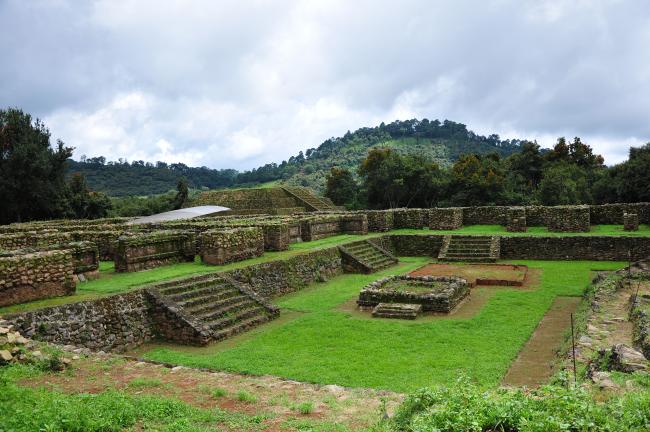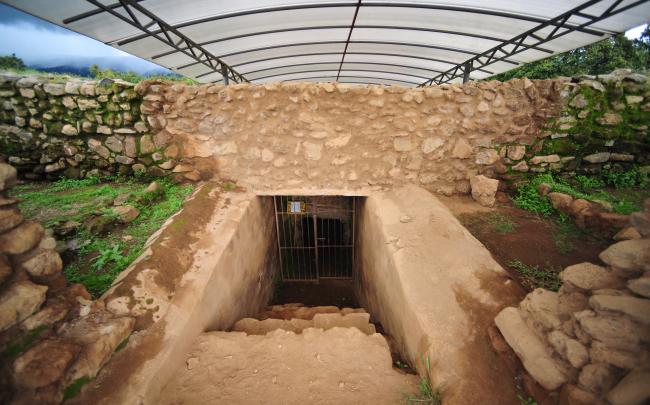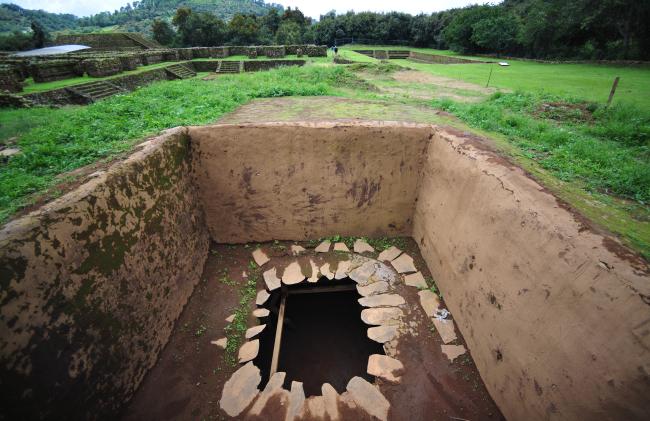
La Gran Plataforma o Plataforma Principal
Estructura
Altars 2 and 3: Delimited by slabs placed vertically, to the center of the patio is the Altar 3, of quadrangular plant and built with the system of slope and board, it has two stairways to the north and south; apparently it had two bodies although only the first one is conserved. To the south of the patio is the Altar 2. This is a stone structure of rectangular form and filled with a type of reddish earth of the region denominated “charanda”.
Housing Complex: This area was destined to the rooms of the ruling class. It is located to the north of the religious architectural group; it has a clear Teotihuacan influence, since it has sunken plazas around which the rooms are organized. Sunken Patio 1 is limited on its four sides by sloping walls. It has stairways with alfardas in each one of them; those of the east side lead to a level in which 11 rooms are located and two of them present in their facade talud-tablero.
Tomb 1: Tomb 1 was built beneath the rooms at the southeast corner of the Great Platform. It is accessed from the Great Platform by a narrow stairway of six irregular steps constructed of stone and mud. At the end of these, a small corridor leads to the tomb. The entrance to the chamber is rectangular and small (measuring 0.80 m high by 1.05 m wide); five slabs placed vertically protected it; a large slab on lateral walls serves as a lintel to this entrance. The chamber, a room with walls approximately 1.4 m high, measures 3.3 m from north to south and 3.4 m from east to west; on the roof, slabs superimposed one on top of the other horizontally gradually close until they meet in the center, forming a dome. The form of the tomb and its access are similar to those of Opeño (these carved in tepetate), near Jacona.
In the tomb the remains of 15 complete skeletons of men and women were found, in addition to fragments of between 50 and 124 other people. Among these, 32 skulls with their respective offerings were found scattered throughout the chamber, which suggest the reuse of the tomb, the existence of ritual decapitation or perhaps the custom of using trophy skulls. The offerings consisted of more than a hundred ceramic, stone and obsidian objects, as well as bone punches, a trumpet shell, a shell bracelet with blue-green stone inlays, nose rings, earrings and necklaces.
Sunken Courtyard 2 and Tomb 2: During the excavations made in 2011, this small sunken courtyard was found, which has its stairways oriented to the cardinal points. The tradition of building sunken patios is widespread in the states of Guanajuato, Zacatecas and Durango. A tomb built 5 m deep was also found under the mound on the west side. Only one individual was found in the chamber, who died between 25 and 30 years of age. He was placed on a bed of flagstones, lying with his head to the west and his feet to the east. His ornaments were very abundant; several thousand shell and bone beads and blue-green stones were found, as well as a large number of small unworked sea shells.






